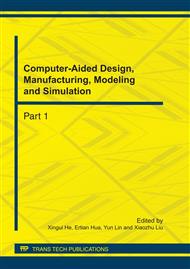[1]
Tang Lixin, Liu Jiyin. Rong Aiying, et al. A Multiple Traveling Salesman Problem Model for Hot Rolling Scheduling in Shanghai Baoshan Iron & Steel Complex. European Journal of Operational Research, 2000, 124(2): 267-282.
DOI: 10.1016/s0377-2217(99)00380-x
Google Scholar
[2]
Yang Tao, Yand Genke, Pan Changcuen. Hot Steel Rolling Plan Optimization Based on Intelligent Branch-bound Algorithm. Microcomputer Applications. 2009, 25(4): 39-42.
Google Scholar
[3]
Gao Zhixin, Li Tieke, Li junfang. Model and Algorithm of Hot Rolling Batch Planning. Journal of Liaoning Technical University(Natural science), 2010, 29(1): 139-142.
Google Scholar
[4]
Zhang Tao, Wang Lie, Zhang Yuejie. PSO Algorithm for Hot-milling Batch Planning Problem Based on PCVRP. Journal of Systems Engineering. 2010, 25(1): 55-61.
DOI: 10.1109/wcica.2008.4593070
Google Scholar
[5]
Ning Shushi, Wang Wei. Model and Algorithm for Hot Rolling Lot Planning. Journal of System Simulation. 2007, 19(3): 691-694.
Google Scholar
[6]
Clifford Mui, Edmud Osinski. John A. Meech et al. A SCADA-based Expert System to Provide Delay Strategies for A Steel Billet Reheat Furnace. IPMM99, Hawaii, USA, 1999: 111-118.
DOI: 10.1109/ipmm.1999.792460
Google Scholar
[7]
Paralic, J. Malindzak, D. Csonto J. Scheduling of Slabs into Push Furnaces-two Different Approaches. Proceedings of the 12th International Conference on Process Control and Simulation. FBERG Technical University of Kosice, Kosice, 1996: 355-360.
Google Scholar
[8]
Ning Shushi, Wang Wei, Liu Quanli. An Optimal Scheduling Algorithm for Reheating Furnace in Steel Production. Control and Decision. 2006, 21(10): 1138-1142.
Google Scholar
[9]
Knoop p. Van Nerom L, Scheduling Requirements for Hot Charge Optimization in An Integrated Plant Record of the Industry Applications Conference on the 38th IAS Annual Meeting. Salt Lake City, USA: IEEE, 2003, 1: 74-78.
DOI: 10.1109/ias.2003.1257486
Google Scholar
[10]
Goldbergd E. Genetic Algorithms in Search, Optimization and Machine Learning. Boston Addison, Wesley Longman Press, (1989).
Google Scholar
[11]
Glover F, Laguna M. Tabu search. Boston: Kluwer Academic Publishers, (1997).
Google Scholar
[12]
Tang Lixin. Improved Genetic Algorithms for TSP. J Northeast Univ Nat Sci, 1999(1)40-43.
Google Scholar
[13]
Bake J. Adaptive Selection Methods for Genetic Algorithms. Proc of the 2nd Int Conf on Genetic Algorithms. Hillsdale; Lawrence Erlbaum Associates, 1987: 100-111.
Google Scholar


